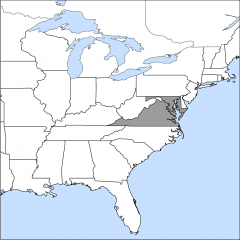Subcalcareous Cliff & Rock Outcrop (Piedmont-Central Appalachian)
Learn More
Where to Explore It
Shrubs, ferns, and flowers cling to rocky cliffs in the Subcalcareous Cliff & Rock Outcrop natural community. (There is more than one type of Subcalcareous Cliff & Rock Outcrop; this one occurs in the Piedmont and in the Central Appalachian mountains.)
This natural community occurs on cliff faces overlooking large rivers.
The range map shows the states in which this natural community has been documented.
More About This Natural Community
The Subcalcareous Cliff & Rock Outcrop is found on rocky cliffs, typically facing north and overlooking a large river. The rocks of the cliff contain calcium-rich minerals, which promote plant growth.
Plants gain a foothold in cracks, fissures, and shelves—wherever a little bit of soil can accumulate. Usually no more than 50% of the cliff is covered by plants, and often much less. Species that are likely to occur here include wild hydrangea, rock polypody, Virginia creeper, eastern poison-ivy, woodland stonecrop, and common blue wood aster.
For a more in-depth look at this community, click on a link under “Where to Explore It.”
Look for It in These National Parks
- Chesapeake and Ohio Canal National Historical Park
- Harpers Ferry National Historical Park
Conservation Status
How vulnerable is a natural community? Is it at risk of elimination? Learn about conservation status.
Classification
Official names reduce confusion by providing a common language for talking about natural communities. Why so many names?



